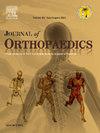全内窥镜下后纵韧带覆盖缝合腰椎间盘突出症伴环状缺损
IF 1.5
Q3 ORTHOPEDICS
引用次数: 0
摘要
背景:探讨全内镜下纤维环缺损区后纵韧带覆盖缝合治疗腰椎间盘突出症的临床疗效。方法回顾性分析我院2018年3月至2023年7月行LDH全内镜手术的56例患者,镜下发现纤维环部分缺损。其中,单纯行全内镜下腰椎间盘切除术34例(对照组),行纤维环缺损后后纵韧带覆盖缝合治疗22例(观察组)。比较两组围手术期、随访及影像学资料。结果两组均未发生严重并发症。观察组手术时间更长(67.23±8.85 min vs. 54.38±8.16 min);0.05),但在切口长度、出血量或住院时间方面无差异(P >;0.05)。随访12 ~ 18个月(平均14.3±0.2个月),对照组6例(17.6%)复发,观察组无复发(P <;0.05);1例复发需要再手术,两组间再手术率无差异(P >;0.05)。术前VAS和ODI评分具有可比性(P >;0.05),两组术后均有显著下降(P <;0.05),但组间差异不显著(P >;0.05)。两组患者术后Pfirrmann评分均显著提高(P <;0.05),但组间差异无统计学意义(P >;0.05)。全内窥镜下后纵韧带覆盖缝合术能有效修复腰椎间盘环缺损,减少复发,临床疗效显著。结论在纤维环缺损区采用全内镜下后纵韧带覆盖缝合,可有效修复纤维环缺损,降低LDH复发率,治疗腰椎间盘突出伴纤维环缺损,临床效果满意。本文章由计算机程序翻译,如有差异,请以英文原文为准。
Full-endoscopic posterior longitudinal ligament coverage suturing for lumbar disc herniation with annular defects
Background
To investigate the clinical efficacy of full-endoscopic posterior longitudinal ligament (PLL) coverage suturing in the area of the defective annulus fibrosus for the treatment of lumbar disc herniation (LDH).
Methods
Retrospective analysis of patients who underwent full-endoscopic surgery for LDH in our hospital from March 2018 to July 2023, there were 56 cases presented with partial defects of the annulus fibrosus detected microscopically. Among these, 34 cases were treated with full-endoscopic lumbar discectomy alone (control group), whereas 22 cases were treated with posterior longitudinal ligament coverage of annulus fibrosus defects with suturing following lumbar discectomy (observation group). Perioperative, follow-up and imaging data were compared between the two groups.
Results
No severe complications occurred in either group. The observation group had longer surgical time (67.23 ± 8.85 vs. 54.38 ± 8.16 min, P < 0.05), but no differences in incision length, blood loss, or hospital stay (P > 0.05). At 12–18-month follow-up (mean 14.3 ± 0.2 months), recurrence was observed in 6 patients (17.6 %) in the control group versus none in the observation group (P < 0.05); one recurrence required reoperation, with no intergroup difference in reoperation rates (P > 0.05). Preoperative VAS and ODI scores were comparable (P > 0.05), and both groups showed significant postoperative reductions (P < 0.05), though intergroup differences were insignificant (P > 0.05). Pfirrmann grading improved significantly in both groups postoperatively (P < 0.05) but did not differ between groups (P > 0.05). Full-endoscopic posterior longitudinal ligament coverage suturing effectively repaired annular defects, reduced recurrence, and demonstrated clinical efficacy for lumbar disc herniation.
Conclusions
Lumbar disc herniation with annulus fibrosus defects can be treated with satisfactory clinical efficacy by using full-endoscopic posterior longitudinal ligament coverage suturing in the area of the defective annulus fibrosus, which can effectively repair fibrous annulus defects and reduce the recurrence rate of LDH.
求助全文
通过发布文献求助,成功后即可免费获取论文全文。
去求助
来源期刊

Journal of orthopaedics
ORTHOPEDICS-
CiteScore
3.50
自引率
6.70%
发文量
202
审稿时长
56 days
期刊介绍:
Journal of Orthopaedics aims to be a leading journal in orthopaedics and contribute towards the improvement of quality of orthopedic health care. The journal publishes original research work and review articles related to different aspects of orthopaedics including Arthroplasty, Arthroscopy, Sports Medicine, Trauma, Spine and Spinal deformities, Pediatric orthopaedics, limb reconstruction procedures, hand surgery, and orthopaedic oncology. It also publishes articles on continuing education, health-related information, case reports and letters to the editor. It is requested to note that the journal has an international readership and all submissions should be aimed at specifying something about the setting in which the work was conducted. Authors must also provide any specific reasons for the research and also provide an elaborate description of the results.
 求助内容:
求助内容: 应助结果提醒方式:
应助结果提醒方式:


